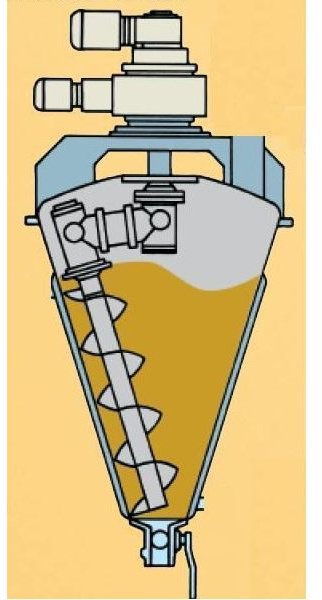Vertical Cone Screw Blender
Design, Construction and Operation
A vertical cone screw blender consists of a conical shape vessel with a screw agitator that rotates about its own axis while orbiting around the vessel’s periphery. The drive system consists of two motors; one for rotation of the main drive, the other for the rotation of the screw. The screw is well supported from the top drive assembly. Depending on the size of the blender and the application, it can also supported at the bottom by a support bearing. The general arrangement of the vertical cone screw blender is shown in Figure 1.
The charging of material is from the top of the vessel. Because of the vertical configuration and the conical shape of the vessel, this blender can operate efficiently with batch sizes ranging from 10% to 100% of the total working capacity of the blender. In operation, the screw shaft rotates around the periphery of the cone and the screw turns such that the pitch gently lifts the material from the bottom of the mixer to the top. The materials get directed towards the center of the vessel, and then move down the center, while mixing with materials being moved upward by the orbiting screw. The discharge of the material is through a valve located at the bottom of the cone. The vertical cone screw blender gives nearly 100% discharge. Fast discharge is achieved with the unsupported screw design at the lower end.
The blending action in the vertical cone screw blender is much gentler than that of a horizontal ribbon type blender. Products that require low-impact, gentle blending are best handled in a vertical cone screw blender. The screw rotates at low speeds, typically 35 to 100 metres per minute. Because of lower operating speed of the vertical cone blender, the wear is lower. Slower blending speeds is advantageous for heat sensitive products.
The power consumption in the vertical cone blender is lower compared to the ribbon blender. A 3000 liters vertical screw blender is typically powered by a 20 horsepower main drive motor and an orbital arm by a 2 horsepower motor. For the same volume the ribbon blender consumes almost twice the power. The efficiency of the vertical cone blender can reduce operating cost due to its lower power consumption per unit volume.
Advantages of Vertical Cone Screw Blender
Flexibility of Batch Size
Because of the vessel geometry and configuration the vertical cone screw blender can operate efficiently with batches as small as 10% of blender capacity. The ribbon blender generally requires a minimum of 40% of the total working capacity.
Homogenous Mixing
Better mixing efficiency and product quality are achieved in a vertical cone screw blender when compared to the ribbon blender.
Gentle Blending Action
The blending action of the slow turning mixing screw is very gentle. It is therefore suitable for friable and heat sensitive products.
Complete Discharge
The vertical cone screw blender gives nearly 100% discharge through the lower cone.
Lower Risk of Contamination
The stuffing box is located above the working level of the material. As a result the material does not come in contact with the process material and the risk of product contamination is minimized.
Easy Cleaning
Vertical screw blenders are easier to clean compared to the ribbon blenders since the stuffing box, packing glands do not come in contact with the process material.
Disadvantages of Vertical Cone Screw Blender
High Head Room
The biggest drawback of this type of blender is the high head space for installation of production size units.
Expensive
The ribbon blender is generally less expensive than a vertical cone screw blender of comparable capacity.
Applications
Vertical blenders provide are best suited for applications where the material to be mixed is shear sensitive, heat sensitive, or where the process parameters are critical. Though this blender is generally used for solids-solids blending, designs are adapted for liquid-solid blending and wet granulations.
